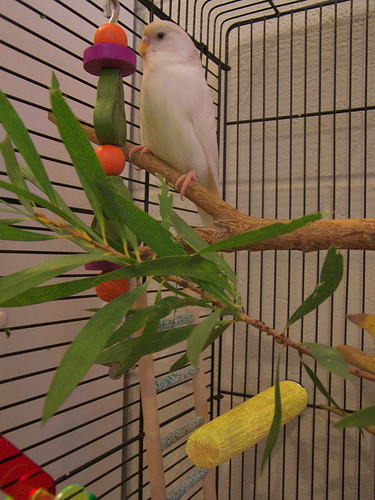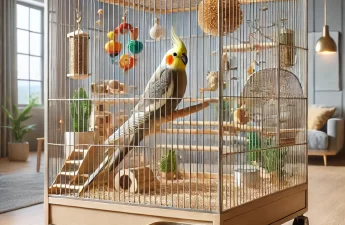When a parakeet is not out flying free, a cage in their home. There are a few steps that can be taken to ensure that your parakeet is happy and safe within their cage. Provided here are some standard recommendations for parakeet cages.
Parakeet Cage Size
Parakeets love to fly around and can become very active and energetic. For this reason it’s recommended that the cage be at least 18 inches long by 18 inches wide. This is ideal for one or two parakeets and provides ample room to fly around. If space allowed it the best cage size to get would be the 30 inches long variety as there is even more room for the parakeet to fly and enjoy themselves in. However, space does not always allow such a large cage and in that case the 18 inch cage is just perfect.

Fighting Female Parakeets
When purchasing a couple of female parakeets it can become quite crowded in the cage. Females
can get overly aggressive and start to fight each other. Parakeet
fights can get pretty rough and cause injuries. If you notice that females are fighting each other it is best to invest in another cage and separate them immediately before any injuries can occur.
Food and Water Space
Almost every parakeet cage includes a provided space for food and water. These are essential to keeping the parakeet alive and healthy. If not dishes can be brought and used for the feeding purposes. For recommended food for your parakeet visit our parakeet diet page for recommended food selections.

Something to Chew
Female parakeets love to chew on things. Males will also chew on items but not as much as female parakeets. When parakeets are in the wild a female will gnaw through various areas to create a cavity to lay their eggs. Items that can be used for something to chew on is covered in the parakeet cage ideas page.
Items that can be placed in the cage that parakeets can chew and gnaw on include mineral blocks or cuttlebones, even a piece of wood can provide for their gnawing needs.
Parakeet Perches
Most parakeet cages come with perches that are the size of a pencil. While these types of perches are the most popular, they are also not the best perches for the parakeet. These types are the direct result of many parakeet foot problems from foot cramping, sore feet, broken toe nails and broken joints. Make sure that the perch size is at least an inch and half and these problems can be reduced
The best perch for a parakeet is ideally one that looks like wood or tree branches. If these cannot be provided then it is recommended that you follow the above recommendations.
These are just some of the basic parakeet cage requirements. Toys and other items can spruce the cage up and be found on the Parakeet page site.



